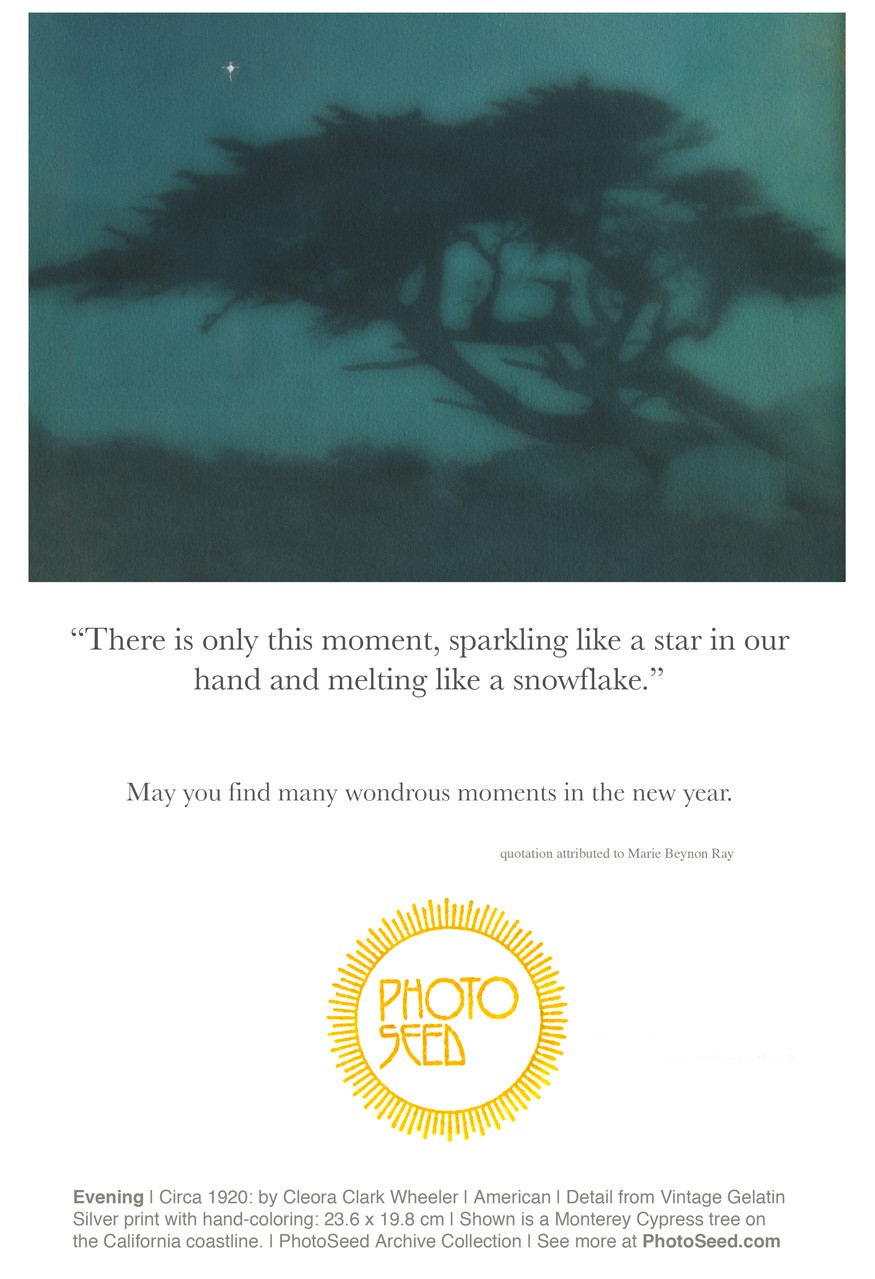Category
Color Photography
14 entries in this category | view all categories
No Junk in Trunk
Posted December 2015 in Alternate Processes, Cameras, Color Photography, New Additions, Photography, Unknown Photographers
If the story is to be believed, the contents of a mystery trunk ⎯the artistic passion of yet another unknown early 20th Century photographer ⎯have been saved once again in the name of photographic collecting. The evidence was several hundred photographs tucked inside:
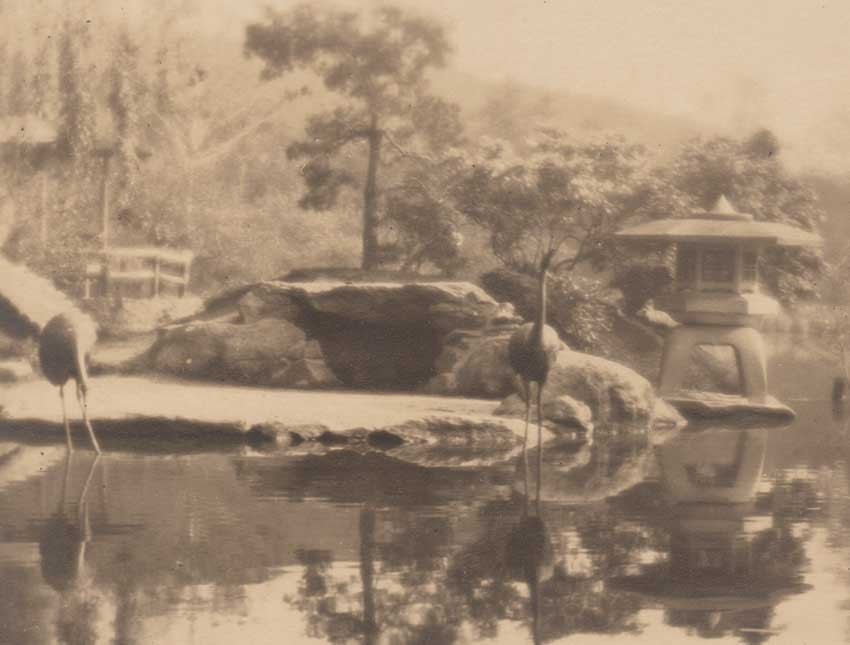 Detail: "Japanese Hill-and-Pond Garden Island" (at Brooklyn, New York Botanic Garden): ca. 1920-25: Unknown Brooklyn photographer: gelatin silver: 8.8 x 11.4 cm | 12.6 x 17.3 cm cream-colored, photographic paper stock: from: PhotoSeed Archive
Detail: "Japanese Hill-and-Pond Garden Island" (at Brooklyn, New York Botanic Garden): ca. 1920-25: Unknown Brooklyn photographer: gelatin silver: 8.8 x 11.4 cm | 12.6 x 17.3 cm cream-colored, photographic paper stock: from: PhotoSeed Archive
”The dealer had bought a trunk from an estate of a lady who had passed away.”
A story I’ve encountered before in my online foraging. My offer, in order to keep the archive together, was fortunately accepted, and now share with you a glimpse of some of these fruits.
Typically, when photographs enter this collection, initial research on origins and other factors are made and then set aside-often for years- until more deductions can be made or oftentimes additional primary source material percolates into that vast library we all humbly know as the public Internet.
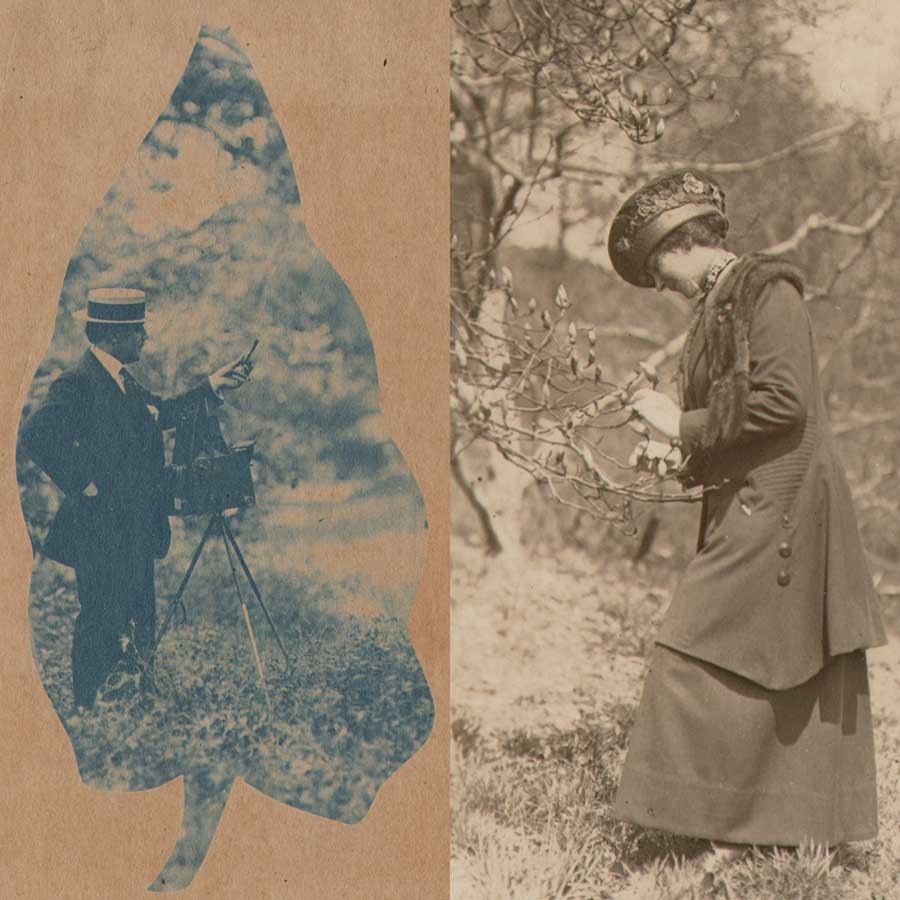 Husband & Wife? L: Detail: "Photographer in Boater Hat Behind Graflex Camera": ca. 1910-1920: Unknown Brooklyn photographer: cyanotype: 11.2 x 5.2 cm | 14.6 x 8.2 cm: image printed within leaf shape on thin cream-colored paper: R: Detail: "Woman Examining Magnolia Blossom": ca. 1910-1920: Unknown Brooklyn photographer: gelatin silver: 11.1 x 7.3 cm | 17.1 x 10.5 cm: both from: PhotoSeed Archive
Husband & Wife? L: Detail: "Photographer in Boater Hat Behind Graflex Camera": ca. 1910-1920: Unknown Brooklyn photographer: cyanotype: 11.2 x 5.2 cm | 14.6 x 8.2 cm: image printed within leaf shape on thin cream-colored paper: R: Detail: "Woman Examining Magnolia Blossom": ca. 1910-1920: Unknown Brooklyn photographer: gelatin silver: 11.1 x 7.3 cm | 17.1 x 10.5 cm: both from: PhotoSeed Archive
But exceptions, at least in my world, always exist. For these latest trunk photographs coming to light, my discovery a small portion documenting a place and event celebrating 100 year anniversaries in 2015 were primary motivators in showcasing them now with this post. These were the establishment of the Japanese Hill-and-Pond Garden in 1915 at the Brooklyn Botanic Garden, considered the first Japanese garden created in an American public garden, as well as a small cache of photographs taken the same year at the Panama-Pacific International Exposition in San Francisco, California.
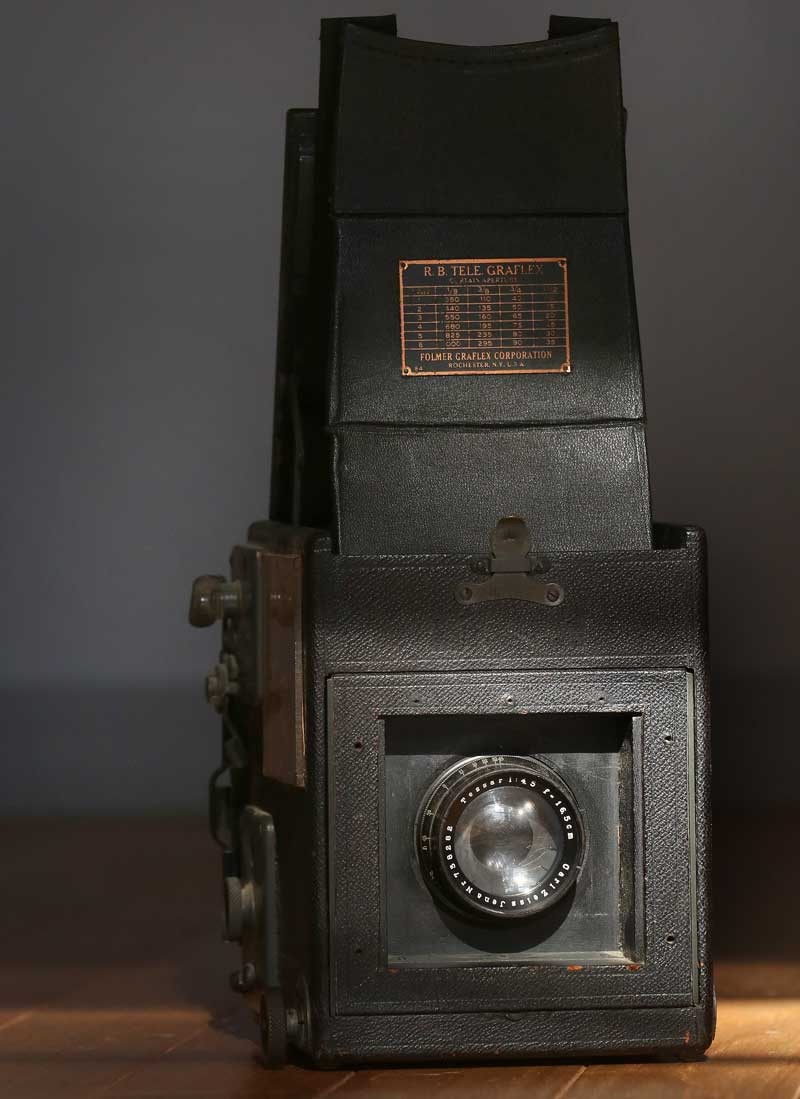 R.B.Tele-Graflex Camera outfitted with Carl Zeiss Tessar lens ca. 1913 (last patent is for June of this year on camera bottom) Manufactured by the Folmer Graflex Corporation, Rochester, New York. The Unknown Brooklyn photographer who took the images seen with this post used a similar Graflex model pictured in the above cyanotype. Lightweight so it could be carried in the field and used on a tripod or hand-held, it features a revolving back so the glass or cut film plates loaded into individual holders could be oriented on the camera back for a vertical or horizontal field of view. The photographer looked through the top of the camera (shown in open position here) and focused on the ground glass inside while bringing the subject into focus by manipulating the bellows (not extended in this photo) using the knob located at the far left of the lens board on lower side of camera. from: PhotoSeed Archive
R.B.Tele-Graflex Camera outfitted with Carl Zeiss Tessar lens ca. 1913 (last patent is for June of this year on camera bottom) Manufactured by the Folmer Graflex Corporation, Rochester, New York. The Unknown Brooklyn photographer who took the images seen with this post used a similar Graflex model pictured in the above cyanotype. Lightweight so it could be carried in the field and used on a tripod or hand-held, it features a revolving back so the glass or cut film plates loaded into individual holders could be oriented on the camera back for a vertical or horizontal field of view. The photographer looked through the top of the camera (shown in open position here) and focused on the ground glass inside while bringing the subject into focus by manipulating the bellows (not extended in this photo) using the knob located at the far left of the lens board on lower side of camera. from: PhotoSeed Archive
But there’s more as they say. Many of the photographs: gorgeous little jewels printed directly onto small impressed and ruled pieces of photographic paper which act as mounts-some toned in verdant hues of green for landscapes, blues for seascapes and others beautifully hand-colored, are known to have been taken in the mother of the Brooklyn Botanic Garden itself, the expansive 585-acre Prospect Park designed by Frederick Law Olmsted and Calvert Vaux- Brooklyn’s version of New York City’s Central Park which is celebrating its’ 150th anniversary in 2016.
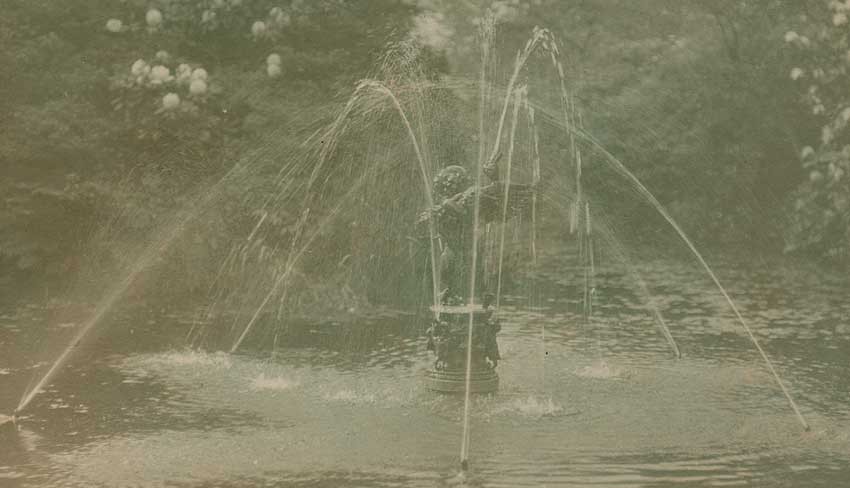 Detail: "Boy and Duck Fountain in Vale of Cashmere", sculpture by Frederick William MacMonnies, American: 1863-1937 (at Brooklyn Botanic Garden): ca. 1910-20: Unknown Brooklyn photographer: green toned gelatin silver: 8.8 x 11.6 cm|12.4 x 16.9 cm: from: PhotoSeed Archive
Detail: "Boy and Duck Fountain in Vale of Cashmere", sculpture by Frederick William MacMonnies, American: 1863-1937 (at Brooklyn Botanic Garden): ca. 1910-20: Unknown Brooklyn photographer: green toned gelatin silver: 8.8 x 11.6 cm|12.4 x 16.9 cm: from: PhotoSeed Archive
Frustratingly, the photographer’s identity responsible for these fruits is presently unknown, other than a cyanotype image included with the collection showing a dapper gentleman believed to be this person standing behind a tripod-mounted Graflex model camera. Photographically printed within the outlines of a leaf while standing in a park-like setting, he wears a straw boater hat while dressed in a suit and raises his hand clenching a pipe towards the scene before him as if to say, “now that’s a scene worthy of my camera”, or something to that effect.
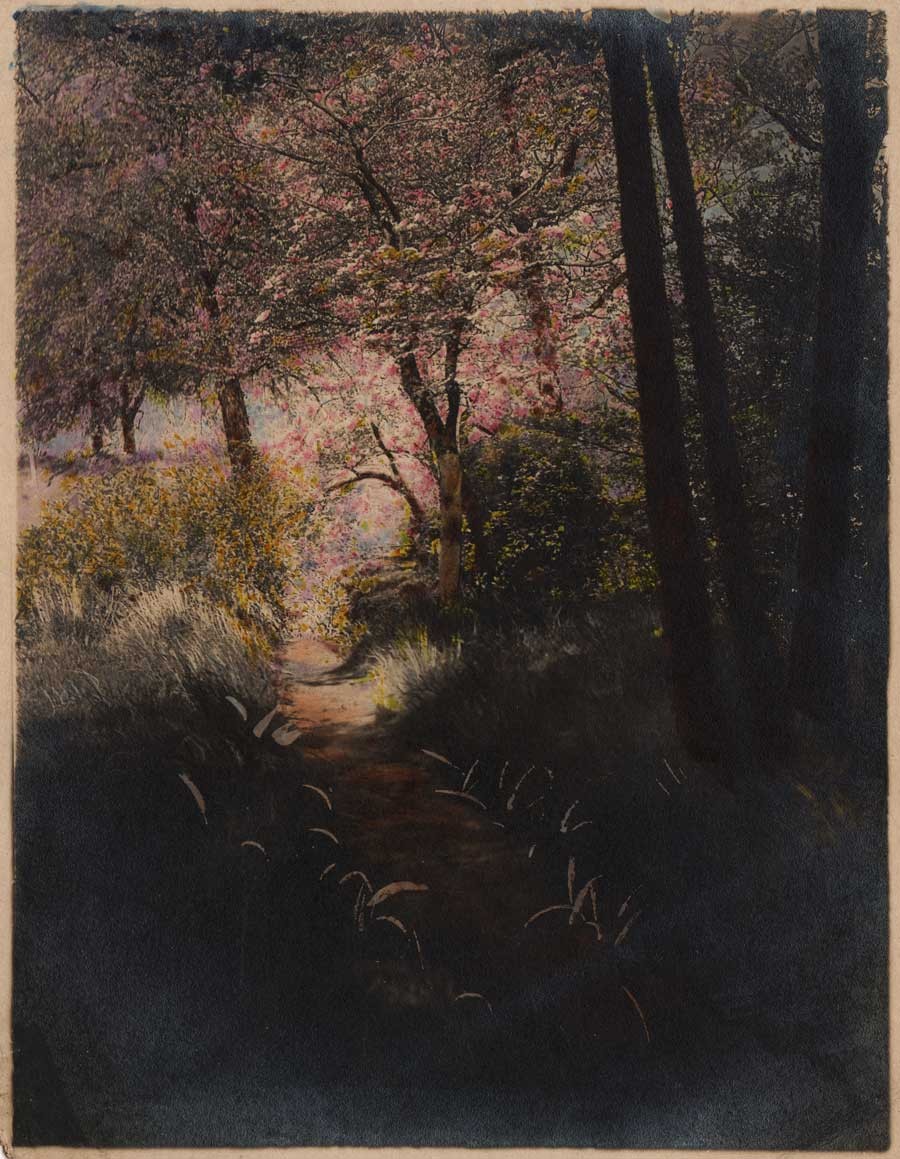 "Spring at Prospect Park"(Brooklyn, New York): ca. 1910-20: Unknown Brooklyn photographer: hand-colored gelatin silver: 11.8 x 9.0 cm | 13.2 x 9.9 cm: from: PhotoSeed Archive
"Spring at Prospect Park"(Brooklyn, New York): ca. 1910-20: Unknown Brooklyn photographer: hand-colored gelatin silver: 11.8 x 9.0 cm | 13.2 x 9.9 cm: from: PhotoSeed Archive
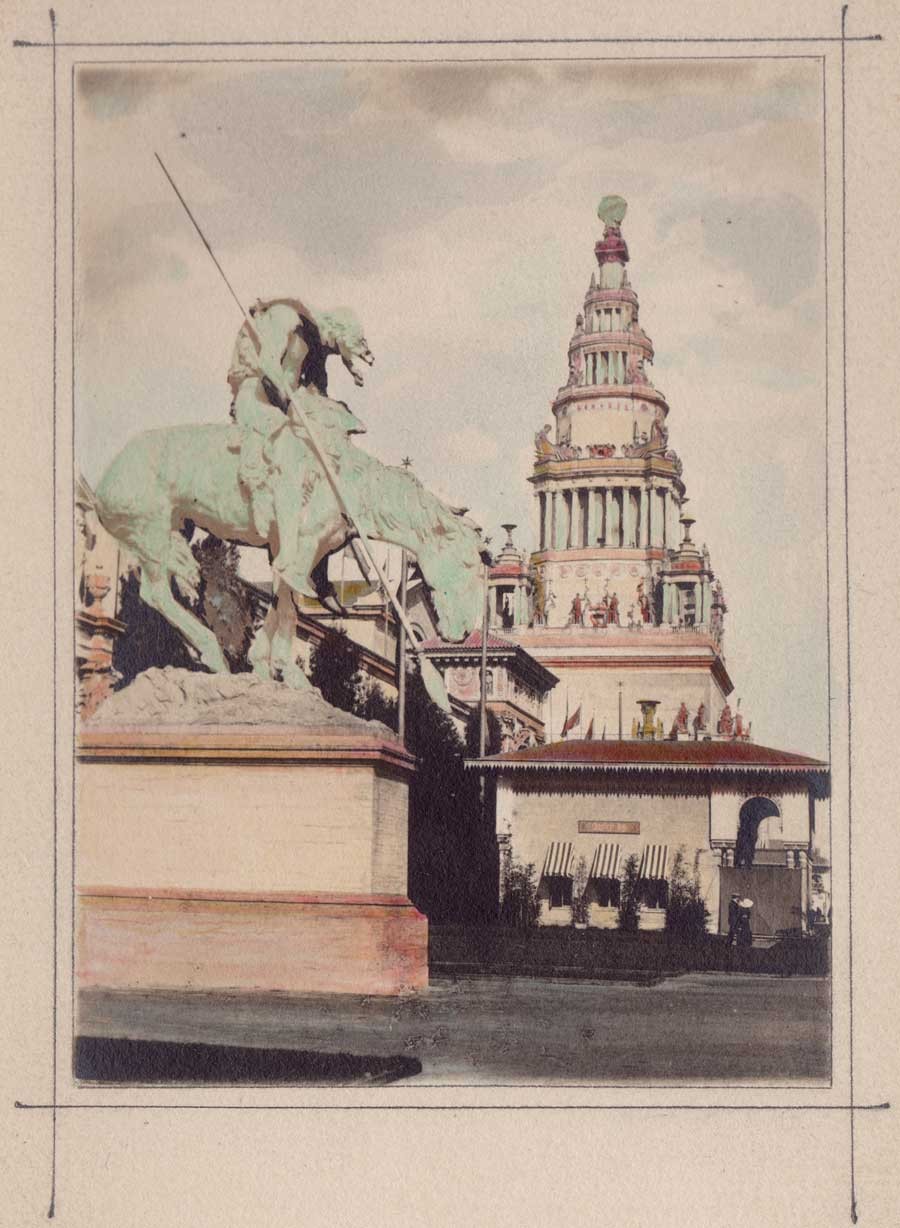 "The End of the Trail": sculpture by James Earle Fraser (American: 1876-1953) at Panama-Pacific International Exposition, San Francisco, California (Tower of Jewels in background) : 1915: Unknown Brooklyn photographer: hand-ruled & colored gelatin silver: 11.0 x 8.0 cm | 17.1 x 11.5 cm: from: PhotoSeed Archive
"The End of the Trail": sculpture by James Earle Fraser (American: 1876-1953) at Panama-Pacific International Exposition, San Francisco, California (Tower of Jewels in background) : 1915: Unknown Brooklyn photographer: hand-ruled & colored gelatin silver: 11.0 x 8.0 cm | 17.1 x 11.5 cm: from: PhotoSeed Archive
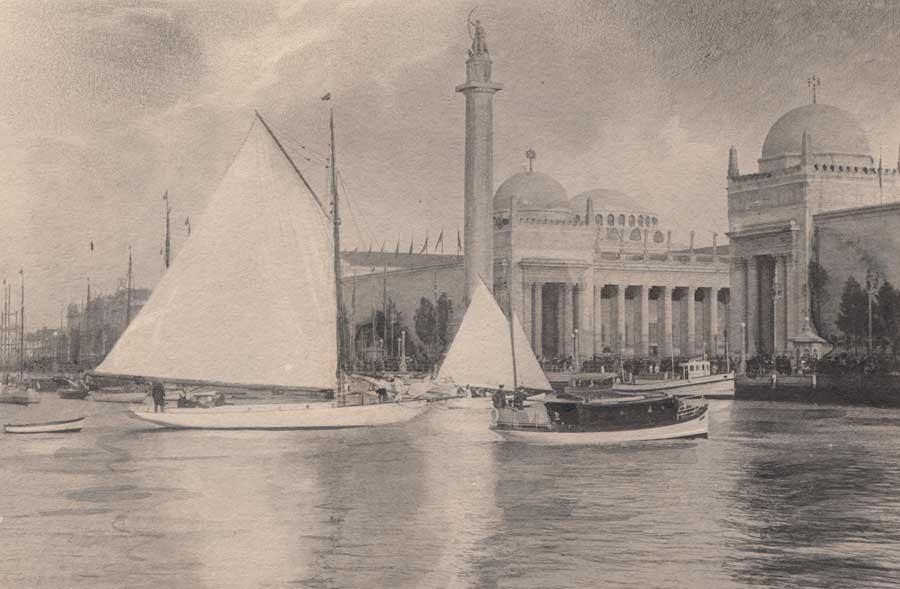 Detail: "Yacht Harbor at Panama-Pacific International Exposition" (Palaces of Agriculture & Transportation in background): 1915: Unknown Brooklyn photographer: gelatin silver with ink wash & photographic border: 7.4 x 11.5 cm | 11.4 x 17.8 cm: from: PhotoSeed Archive
Detail: "Yacht Harbor at Panama-Pacific International Exposition" (Palaces of Agriculture & Transportation in background): 1915: Unknown Brooklyn photographer: gelatin silver with ink wash & photographic border: 7.4 x 11.5 cm | 11.4 x 17.8 cm: from: PhotoSeed Archive
Several other photographs showing an unknown woman, most likely the photographer’s wife, or perhaps the artist herself, (can’t be ruled out) were also included in the trunk photographs. In one, a full-length profile view, she examines a Magnolia blossom in a park setting. (shown here) In another, her gaze is directed towards the camera while wearing an Asian influenced floral dress posing in front of blooming Wisteria vines. The dealer who had initially acquired the photographs, according to the seller I purchased them from, stated they had been acquired from the estate of a woman, (most likely depicted in the photographs) who had (presumably) attended or graduated from Wesleyan Female College, (now Wesleyan College) in Macon, Georgia at the turn of the 20th Century.
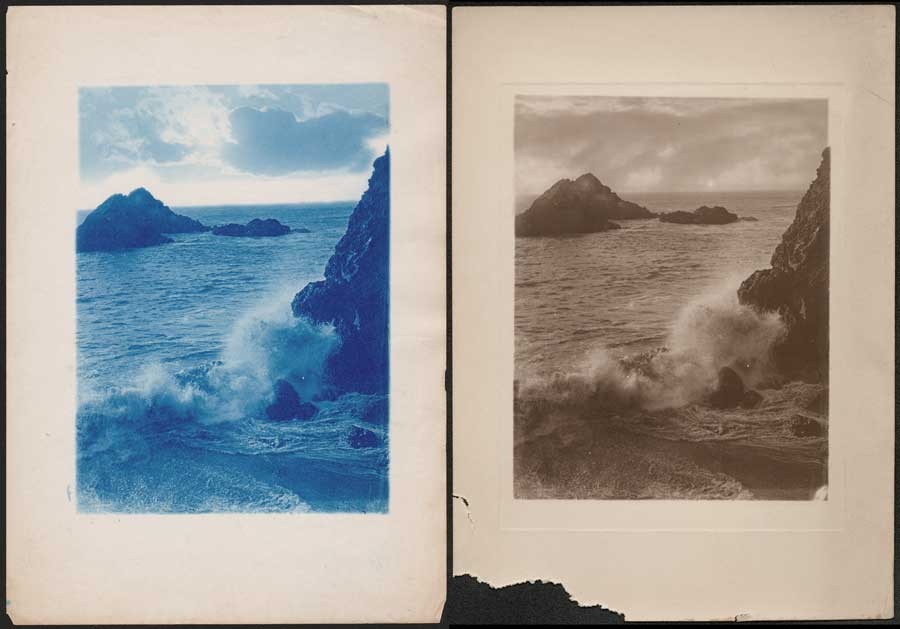 L: "Coastline with Rocks & Wave Action" (possibly California ) :12.3 x 9.0 cm | 17.7 x 12.6 cm: ca. 1910-1920: Unknown Brooklyn photographer: cyanotype with addition of clouds from alternate source photo: R: variant: "Coastline with Rocks & Wave Action" (possibly California) : 11.5 x 9.0 cm | 17.6 x 12.7 cm: ca. 1910-1920: Unknown Brooklyn photographer: gelatin silver: (mouse damage to lower margin): both from: PhotoSeed Archive
L: "Coastline with Rocks & Wave Action" (possibly California ) :12.3 x 9.0 cm | 17.7 x 12.6 cm: ca. 1910-1920: Unknown Brooklyn photographer: cyanotype with addition of clouds from alternate source photo: R: variant: "Coastline with Rocks & Wave Action" (possibly California) : 11.5 x 9.0 cm | 17.6 x 12.7 cm: ca. 1910-1920: Unknown Brooklyn photographer: gelatin silver: (mouse damage to lower margin): both from: PhotoSeed Archive
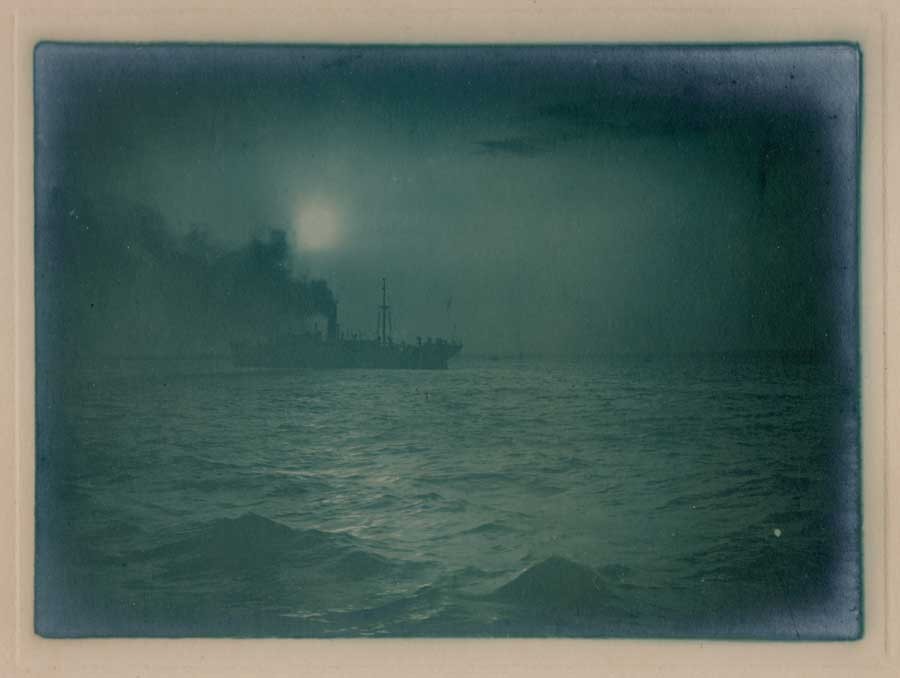 "Steamer in New York Harbor": ca. 1910-20: Unknown Brooklyn photographer: green toned gelatin silver: 8.4 x 11.6 cm | 12.3 x 17.9 cm: from: PhotoSeed Archive
"Steamer in New York Harbor": ca. 1910-20: Unknown Brooklyn photographer: green toned gelatin silver: 8.4 x 11.6 cm | 12.3 x 17.9 cm: from: PhotoSeed Archive
And even though the photographs ended their life residing in a mystery trunk in the American South, I’ll label them for now as being the work of Unknown Brooklyn, in order to keep their attribution consistent for those searching this archive going forward.
New Year Greetings from PhotoSeed
Posted January 2013 in Color Photography, PhotoSeed
The Beauty of Color
Posted December 2012 in Advertising, Color Photography
It is always a pleasure to run across vintage advertising featuring photographs from this archive. Marian Pearce, an amateur from Waukegan, IL, was the grand prize winner in 1908 for this original platinum photograph in the Eastman Kodak Company’s annual advertising contest. Her winning entry, featuring a young girl snapping a photo of her (presumed) younger sister with a Brownie camera appeared in the Ladies Home Journal the following year.
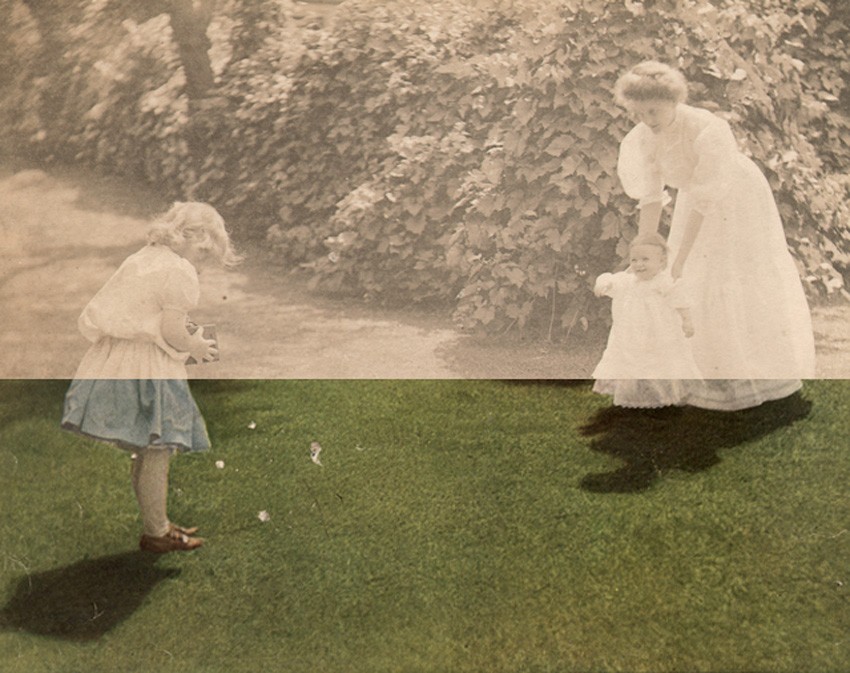 Composite illustration: top: Mrs. W.W. Pearce: black & white detail: from original platinum print: "1908 Kodak Photographic Advertising Contest First Prize Winner, Amateur Class": 15.3 x 19.3 cm | bottom: detail: 3-color halftone: from "Let the Children Kodak", by the Eastman Kodak Company reproduced in June, 1909 issue of the American magazine "Ladies Home Journal"
Composite illustration: top: Mrs. W.W. Pearce: black & white detail: from original platinum print: "1908 Kodak Photographic Advertising Contest First Prize Winner, Amateur Class": 15.3 x 19.3 cm | bottom: detail: 3-color halftone: from "Let the Children Kodak", by the Eastman Kodak Company reproduced in June, 1909 issue of the American magazine "Ladies Home Journal"
What was unexpected was seeing the photograph in the ad published in color. Eastman Kodak advertising manager L.B. Jones oversaw this campaign, with the theme of “Let the Children Kodak.” The three-color halftone process used to reproduce the photo in the June, 1909 issue of the magazine may have been the result of a hand-colored version of the Pearce photograph.
 "Let the Children Kodak" : vintage advertisement in June, 1909 issue of "Ladies Home Journal": from: online resource: Emergence of Advertising in America: 1850-1920: Duke University David M. Rubenstein Rare Book & Manuscript Library
"Let the Children Kodak" : vintage advertisement in June, 1909 issue of "Ladies Home Journal": from: online resource: Emergence of Advertising in America: 1850-1920: Duke University David M. Rubenstein Rare Book & Manuscript Library
Sadly, Mrs. Pearce is not given credit for the photo in the ad, which is of course still common today, although her grand prize of $300.00 she earned in the amateur category of the 1908 contest was a king’s ransom for the time.
New Fruit in Color, Black & White, and Shades in Between
Posted August 2011 in Color Photography, Journals, New Additions, PhotoSeed
Since PhotoSeed launched a month ago, I have been putting together material on a run of the important German photographic journal known as Photographische Mitteilungen. (Photographic Reports) Several hundred photographs, almost all of them hand-pulled photogravures, are now searchable in our archive database. As a working photographer myself, it is an honor to be able to give new light to this material and introduce fresh eyes to it over a century later.
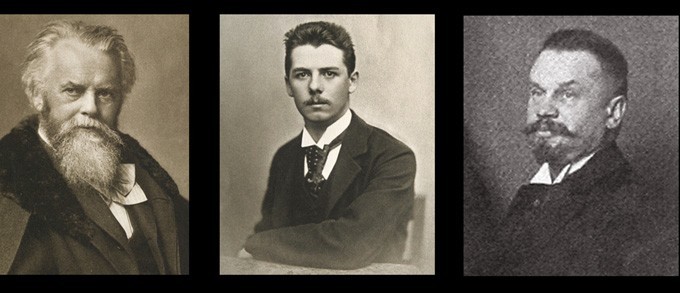 From left to right: Photographische Mitteilungen founder and editor H.W. Vogel: 1864-1898; his son Dr. Ernst Vogel, who edited the journal from at least 1893-1901; and Paul Hanneke-sole editor from 1901-1911.
From left to right: Photographische Mitteilungen founder and editor H.W. Vogel: 1864-1898; his son Dr. Ernst Vogel, who edited the journal from at least 1893-1901; and Paul Hanneke-sole editor from 1901-1911.The challenge for me has been trying to get things right the first time. The language barrier in assessing this material has often been difficult in some cases to overcome. But fear not. If I’m not comfortable about something regarding a translation, I will probably not include it unless I spell it out verbatim on the site-which I have done in a few cases already. I wish I could say I spoke five languages but since four years of high school French is my reality, Google as well as other online translation software has taken up the slack in this department. I have been translating titles of the work where appropriate (found in the misc. tags area) in order to give our English-speaking audience an idea what the photographer’s intent was as well. “Unidentified” seems to be my new favorite word on some days but consistency will always be my mantra while adding material to the site.
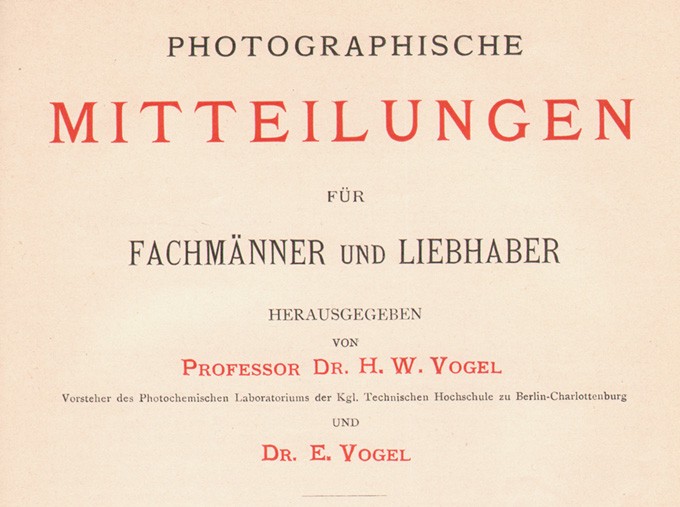 This detail shows the title page for the 30th year of Photographische Mitteilungen covering 1893-1894.
This detail shows the title page for the 30th year of Photographische Mitteilungen covering 1893-1894.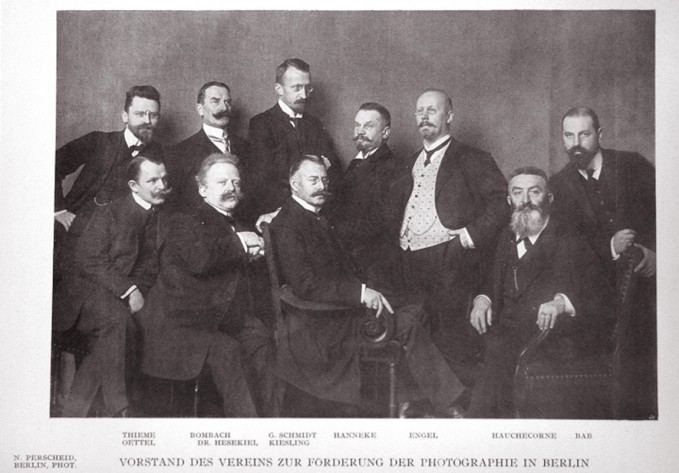 This photograph taken by Berlin photographer Nicola Percheid from the March, 1909 issue of Photographische Mitteilungen shows board members of the Association for the Promotion of Photography in Berlin. (Vorstand des Vereins zur Förderung der Photographie in Berlin) This is the same organization founded by H.W. Vogel in 1863. In the early years of the publication, the name was incorporated into the title page since the journal was actually its mouthpiece. (example- Photographische Mittheilungen: Zeitschrift des Vereins zur Förderung der Photographie) Over the years, the journal lost the "h" in Mittheilungen as well. Seen in this photograph at center is journal editor Paul Hanneke and to his right, journal publisher Gustav Schmidt.
This photograph taken by Berlin photographer Nicola Percheid from the March, 1909 issue of Photographische Mitteilungen shows board members of the Association for the Promotion of Photography in Berlin. (Vorstand des Vereins zur Förderung der Photographie in Berlin) This is the same organization founded by H.W. Vogel in 1863. In the early years of the publication, the name was incorporated into the title page since the journal was actually its mouthpiece. (example- Photographische Mittheilungen: Zeitschrift des Vereins zur Förderung der Photographie) Over the years, the journal lost the "h" in Mittheilungen as well. Seen in this photograph at center is journal editor Paul Hanneke and to his right, journal publisher Gustav Schmidt.
In researching the history of the journal, I discovered early examples of color plates reproduced from 1893. Twenty years earlier, journal founder and photochemist H.W. Vogel had first figured out how color sensitizing agents could be added to photographic plates in order for objects to delineate themselves into their proper shades of gray.
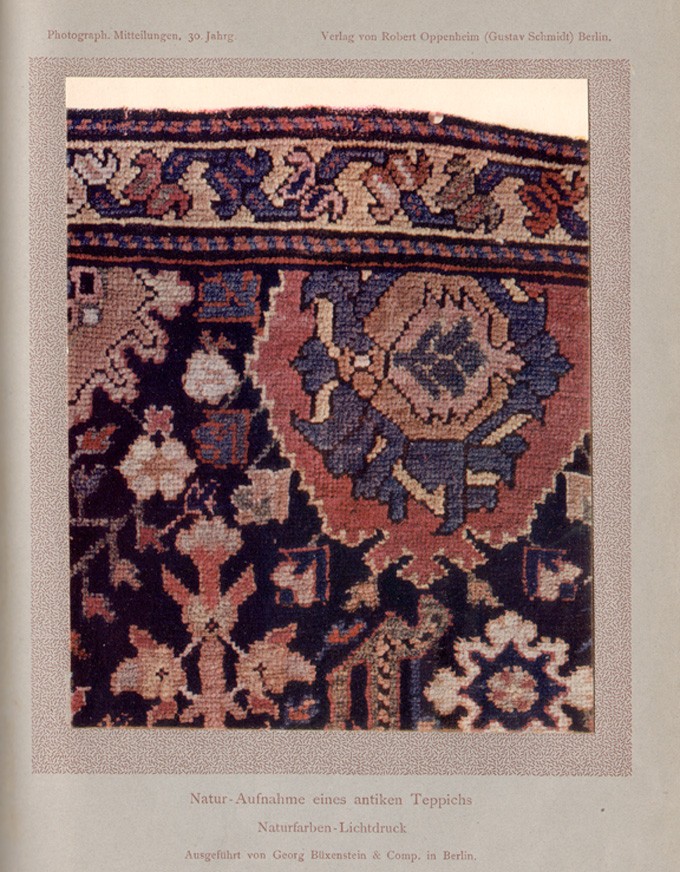 This very early natural-color collotype photograph showing a swatch of an antique rug was done by the atelier Georg Büxenstein in Berlin and reproduced as a full-page plate in the April 15 (heft 2) 1893 issue of Photographische Mitteilungen. Dimensions- image- 15.3 x 12.2 cm -support- 24.4 x 16.9 cm (trimmed)
This very early natural-color collotype photograph showing a swatch of an antique rug was done by the atelier Georg Büxenstein in Berlin and reproduced as a full-page plate in the April 15 (heft 2) 1893 issue of Photographische Mitteilungen. Dimensions- image- 15.3 x 12.2 cm -support- 24.4 x 16.9 cm (trimmed)
Later, his son Ernst Vogel- (who had joined his father as co-editor at an undetermined date but at least since 1893) took up the challenge of printing three-color photographs in halftone as well as collotype. He first teamed up with William Kurtz in New York in 1892 (who was a good friend of his father’s) and a year later with Berlin engraver Georg Büxenstein.
The three-color halftone below showing a still life of fruit reproduced in the January, 1893 issue of the journal is believed to be one of the very first three-color halftones ever done on a large scale. In Berlin, Ernst Vogel’s subsequent business relationship with Büxenstein bore additional fruit in the form of this firm’s exquisite gravure plates now available for your examination on our site.
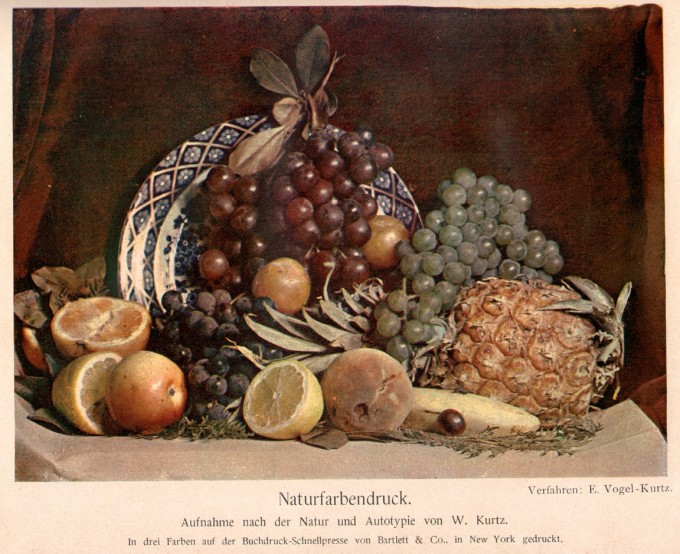 The New York engravers Bartlett & Co. under the direction of William Kurtz and Ernst Vogel printed this very early three-color halftone image. Dimensions: image: 13.3 x 18.3 cm : support: 16.7 x 24.5 cm coated stock paper (trimmed)
The New York engravers Bartlett & Co. under the direction of William Kurtz and Ernst Vogel printed this very early three-color halftone image. Dimensions: image: 13.3 x 18.3 cm : support: 16.7 x 24.5 cm coated stock paper (trimmed)
